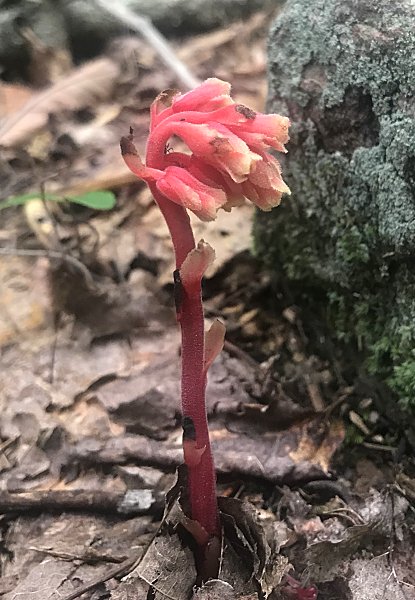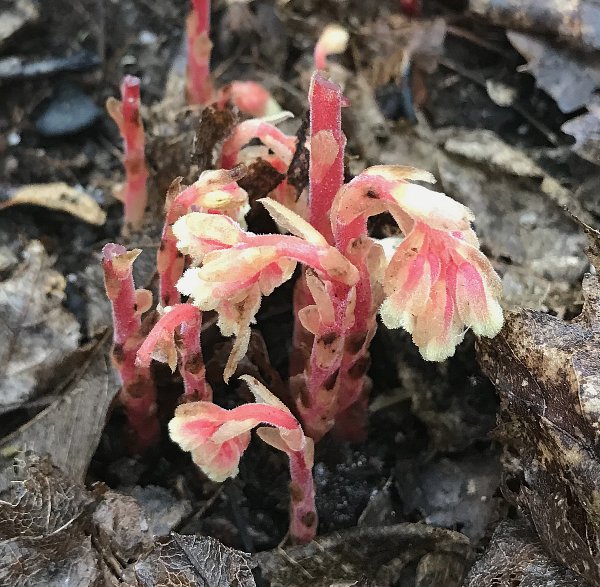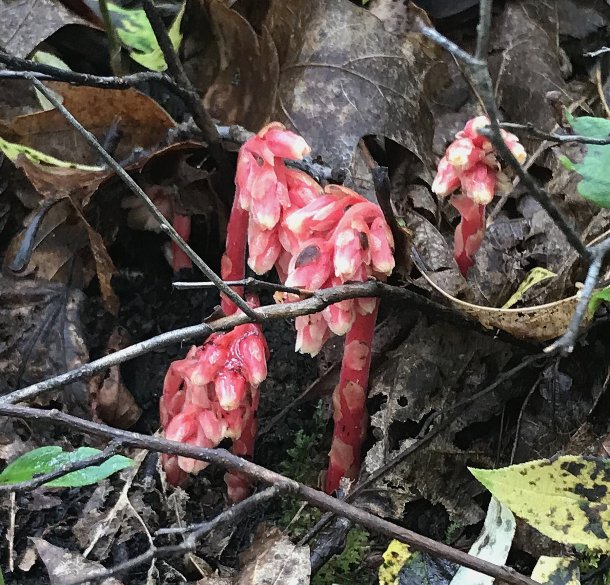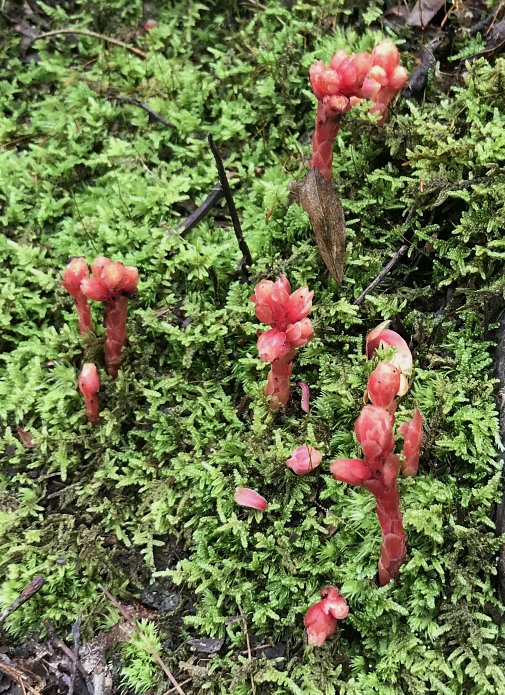Pinesap
Monotropa hypopitys
Heath family (Ericaceae)
Monotropa hypopitys
Heath family (Ericaceae)
Description:
This perennial herbaceous plant is 3–10" (7.5–25 cm.) tall, often
forming clusters of flowering stalks with scale-like leaves. These
plants, including their stems, leaves, and flowers, can be pale yellow,
pale brown, pale red, or red, and they are minutely pubescent; the
plant is also aromatic. The erect central stem is terete, stout,
fleshy, and
unbranched. Sessile alternate leaves occur along the central stem that
are 4–10
mm. long and 2–5 mm. across; they can be sparsely to densely
distributed, and they are either ascending or appressed
against the stem. The leaves can be various shapes, including ovate,
ovate-oblong, lanceolate-oblong, or oval, and their margins are
toothless; sometimes the uppermost margins of the leaves appear eroded
(erose). Sometimes the scale-like leaves are bicolored, becoming
whitish or yellowish along their margins. The inflorescence consists of
a raceme of 2–12 flowers (rarely single-flowered) that nods toward its
tip; the flowers are held laterally or nod toward the ground. The
pedicels (basal stalks) of the flowers are 4–8 mm. long at flowering
time; they become longer after the flowers are replaced by seed
capsules. At the base of each pedicel is a scale-like bract that is
similar in appearance to the scale-like leaves below. Individual
flowers are
9–18 mm. long; they are narrowly and loosely campanulate (bell-shaped).

Each flower has 4–5 sepals, 4–5 petals, 4-5 inserted stamens, and a 4–5 celled ovary with a disk-shaped stigma on a short style; there is a ring of hairs along the lower margin of the stigma. The sepals are shorter and more narrow than the petals. Individual sepals are 7–12 mm. long, 1–5 mm. across, and either linear or lanceolate-oblong to oblanceolate-oblong in shape. Individual petals are 8–17 mm. long, 4–8 mm. across, and ovate-oblong to obovate-oblong in shape. The blooming period occurs primarily during the summer or early autumn, lasting 2–4 weeks for a colony of plants. Afterwards, the flowers are replaced by seed capsules and the entire plant begins to turn brown or black. At maturity, these capsules are 5–7 mm. long, 4–5 mm. across, ovoid-globoid in shape, and thin-walled; they spit open longitudinally between segments to release their seeds. The narrow seeds are about 1 mm. in length and oblong-fusiform in shape; they are small enough to be blown about by the wind. The root system consists of a cluster of fleshy fibrous roots; these roots are parasitically connected to the hyphae of certain soil fungi. Because this plant lacks chlorophyll, it is completely dependent on the fungi for survival.

Cultivation: The preference is moist to dry-mesic conditions and a woodland soil with abundant decaying organic matter; because this plant lacks chlorophyll, sunlight doesn't matter, although it is normally found in shaded to semi-shaded areas. It also requires the presence of specific soil fungi in the soil in order to survive.
Range & Habitat: The native Pinesap (Monotropa hypopitys) occurs in widely scattered areas of Illinois, where it is considered uncommon (see Distribution Map). This plant is widely distributed in the United States and it also occurs in Eurasia. Habitats include moist to dry-mesic deciduous woodlands, mixed woodlands (conifers and deciduous trees), coniferous woodlands (north of Illinois), wooded rocky bluffs, and wooded areas along sandstone and limestone cliffs. Pinesap is found in high quality natural areas.

Faunal Associations: Bumblebees cross-pollinate the flowers of Pinesap (Monotropa hypopitys), where both nectar and pollen are available as floral rewards (Yatskievych, 2006; Klooster & Culley, 2009). An oligophagous thrips, Thrips monotropae, is sometimes found in the flowers of Pinesap and those of a similar plant, Indian Pipe (Monotropa uniflora). White-tailed Deer occasionally chomp off the upper one-half of the flowering stalks; such plants can be found in one of the included photos. The seeds of Pinesap may spread to new areas by clinging to the muddy feet or wet fur of mammals in woodlands.
Photographic Location: Woodland areas in SW Virginia. The photos were taken by Paul Showers, Copyright © 2019.

Comments: Depending on its coloration, Pinesap can be an attractive plant when its flowering stalks develop. This coloration varies from one locale to the next and may depend, in part, on what time of year the flowering stalks develop. Pinesap is one of a small number of plants in Illinois that are completely parasitic on either fungi or other plants because they lack chlorophyll. In addition to its ability to directly extract nutrients from the hyphae (fungal strands) of certain soil fungi, Pinesap is also able to indirectly extract nutrients (e.g., sugars) from neighboring trees by using the hyphae of these fungi as intermediate conduits of such nutrients (Björkman, 1960). In contrast, some parasitic plants, such as Beechdrops (Epifagus virginiana) and Cancer Root (Conopholis americana), are able to extract nutrients from neighboring trees directly through their root systems. Pinesap is most similar to another parasitic plant that lacks chlorophyll, Indian Pipe (Monotropa uniflora). It is easily distinguished from this latter species by the following characteristics: 1) Pinesap almost always has several flowers per stalk, while Indian Pipe has only one flower per stalk, 2) the foliage and flowers of Pinesap can assume several different colors, but they are rarely white, which is the predominant color of Indian Pipe, and 3) the foliage and flowers of Pinesap are minutely hairy, while those of Indian Pipe are hairless. Both of these species occur in similar habitats; in Illinois, Pinesap is less common than Indian Pipe. In older sources, the scientific name of Pinesap is often spelled Monotropa hypopithys, however this is considered an error. An alternative scientific name of this plant that is sometimes used is Hypopitys monotropa.

Each flower has 4–5 sepals, 4–5 petals, 4-5 inserted stamens, and a 4–5 celled ovary with a disk-shaped stigma on a short style; there is a ring of hairs along the lower margin of the stigma. The sepals are shorter and more narrow than the petals. Individual sepals are 7–12 mm. long, 1–5 mm. across, and either linear or lanceolate-oblong to oblanceolate-oblong in shape. Individual petals are 8–17 mm. long, 4–8 mm. across, and ovate-oblong to obovate-oblong in shape. The blooming period occurs primarily during the summer or early autumn, lasting 2–4 weeks for a colony of plants. Afterwards, the flowers are replaced by seed capsules and the entire plant begins to turn brown or black. At maturity, these capsules are 5–7 mm. long, 4–5 mm. across, ovoid-globoid in shape, and thin-walled; they spit open longitudinally between segments to release their seeds. The narrow seeds are about 1 mm. in length and oblong-fusiform in shape; they are small enough to be blown about by the wind. The root system consists of a cluster of fleshy fibrous roots; these roots are parasitically connected to the hyphae of certain soil fungi. Because this plant lacks chlorophyll, it is completely dependent on the fungi for survival.

Cultivation: The preference is moist to dry-mesic conditions and a woodland soil with abundant decaying organic matter; because this plant lacks chlorophyll, sunlight doesn't matter, although it is normally found in shaded to semi-shaded areas. It also requires the presence of specific soil fungi in the soil in order to survive.
Range & Habitat: The native Pinesap (Monotropa hypopitys) occurs in widely scattered areas of Illinois, where it is considered uncommon (see Distribution Map). This plant is widely distributed in the United States and it also occurs in Eurasia. Habitats include moist to dry-mesic deciduous woodlands, mixed woodlands (conifers and deciduous trees), coniferous woodlands (north of Illinois), wooded rocky bluffs, and wooded areas along sandstone and limestone cliffs. Pinesap is found in high quality natural areas.

Faunal Associations: Bumblebees cross-pollinate the flowers of Pinesap (Monotropa hypopitys), where both nectar and pollen are available as floral rewards (Yatskievych, 2006; Klooster & Culley, 2009). An oligophagous thrips, Thrips monotropae, is sometimes found in the flowers of Pinesap and those of a similar plant, Indian Pipe (Monotropa uniflora). White-tailed Deer occasionally chomp off the upper one-half of the flowering stalks; such plants can be found in one of the included photos. The seeds of Pinesap may spread to new areas by clinging to the muddy feet or wet fur of mammals in woodlands.
Photographic Location: Woodland areas in SW Virginia. The photos were taken by Paul Showers, Copyright © 2019.

Comments: Depending on its coloration, Pinesap can be an attractive plant when its flowering stalks develop. This coloration varies from one locale to the next and may depend, in part, on what time of year the flowering stalks develop. Pinesap is one of a small number of plants in Illinois that are completely parasitic on either fungi or other plants because they lack chlorophyll. In addition to its ability to directly extract nutrients from the hyphae (fungal strands) of certain soil fungi, Pinesap is also able to indirectly extract nutrients (e.g., sugars) from neighboring trees by using the hyphae of these fungi as intermediate conduits of such nutrients (Björkman, 1960). In contrast, some parasitic plants, such as Beechdrops (Epifagus virginiana) and Cancer Root (Conopholis americana), are able to extract nutrients from neighboring trees directly through their root systems. Pinesap is most similar to another parasitic plant that lacks chlorophyll, Indian Pipe (Monotropa uniflora). It is easily distinguished from this latter species by the following characteristics: 1) Pinesap almost always has several flowers per stalk, while Indian Pipe has only one flower per stalk, 2) the foliage and flowers of Pinesap can assume several different colors, but they are rarely white, which is the predominant color of Indian Pipe, and 3) the foliage and flowers of Pinesap are minutely hairy, while those of Indian Pipe are hairless. Both of these species occur in similar habitats; in Illinois, Pinesap is less common than Indian Pipe. In older sources, the scientific name of Pinesap is often spelled Monotropa hypopithys, however this is considered an error. An alternative scientific name of this plant that is sometimes used is Hypopitys monotropa.